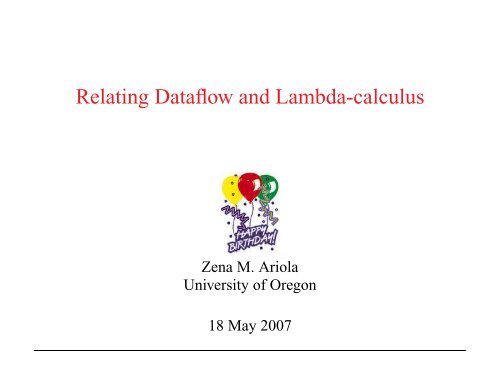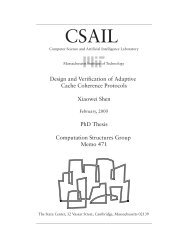Relating Dataflow and Lambda-calculus
Relating Dataflow and Lambda-calculus
Relating Dataflow and Lambda-calculus
You also want an ePaper? Increase the reach of your titles
YUMPU automatically turns print PDFs into web optimized ePapers that Google loves.
<strong>Relating</strong> <strong>Dataflow</strong> <strong>and</strong> <strong>Lambda</strong>-<strong>calculus</strong><br />
Zena M. Ariola<br />
University of Oregon<br />
18 May 2007
CSG in 80’s<br />
World leaders in <strong>Dataflow</strong><br />
Not quite world leaders but extremely interested<br />
in TRS’s <strong>and</strong> λ-<strong>calculus</strong>
Token Pushing Semantics<br />
Operational semantics of ID<br />
Compilation of Id<br />
Optimizations of Id<br />
were expressed in terms of<br />
<strong>Dataflow</strong> Graphs
<strong>Dataflow</strong> Graph
Transformations On <strong>Dataflow</strong> Graphs<br />
Common Subexpression Elimination
Arvind, Pingali, Kathail: Graph<br />
@<br />
λ x +<br />
+ 2 2<br />
x x<br />
Reduction<br />
(λx.x + x)(2 + 2) → (2 + 2) + (2 + 2)<br />
→<br />
+<br />
+<br />
2 2
Sharing of Maximal Free Expressions<br />
Wadsworth: do not repeat some obvious computa-<br />
tion<br />
fun f x = (2 + 2) + x<br />
should you recompute 2+2 every time you apply<br />
f?<br />
Extract Maximal Free Expressions at compile time<br />
(Arvind, Keshav, Pingali HLCA 1984)
Optimality<br />
How much do we have to share to be op-<br />
timal? Lévy theory of optimality<br />
How do you implement that theory?<br />
Vinod why aren’t you here?
In 1985 Corrado Böhm invites Arvind to<br />
the First International Workshop on Re-<br />
duction Machines in Ustica .......
What is Henk Barendregt trying to<br />
explain?
Again.... Arvind <strong>and</strong> Henk Barendregt
Discussions on TRS’s with Jan Willem<br />
Klop were obviously enjoyable
Don’t worry - Gita was there!
Don’t Panic!
After Ustica<br />
Arvind came back speaking λ-<strong>calculus</strong> <strong>and</strong><br />
TRS’s.....<br />
Why not applying these ideas to Id?<br />
Can we use TRS’s <strong>and</strong> λ-<strong>calculus</strong> for Id?
I-structure: Logic Variables
We need to take sharing into account<br />
We introduced an INNOVATIVE system called<br />
Contextual Rewriting System (CRS)<br />
Klop, Lévy =⇒ Graph Rewriting System
Graph Rewriting<br />
Categorical approach: single or double pushouts – Too abstract<br />
Implementation approach: allocations of nodes <strong>and</strong> redirections – Too<br />
low level<br />
Equational Graph Rewriting System<br />
TRS’s + Letrec<br />
λ-<strong>calculus</strong> + Letrec
Equational GRS<br />
Give a name to each node of the graph <strong>and</strong> write down the intercon-<br />
nections via a system of recursive equations<br />
x: +<br />
y: +<br />
2 2<br />
〈x | x = y + y,y = 2 + 2〉<br />
〈x | x = y + y,y = z + w,z = 2,w = 2〉<br />
〈y + y | y = 2 + 2〉
Graph Reduction<br />
double x → x + x<br />
〈z | z = double y, y = 2 + 2〉 → 〈z | z = y + y,y = 2 + 2〉<br />
double<br />
+<br />
2 2<br />
→<br />
+<br />
+<br />
2 2
Two Intermediate Languages<br />
P-TAC - Parallel Three Address Code - TRS + Letrec (FPCA’89)<br />
Kid - Kernel Id - λ-<strong>calculus</strong> + Letrec (PEPM’91)<br />
aaaaaaa<br />
Id<br />
KId<br />
P_TAC<br />
dataflow graphs
Optimizations as rewrite rules<br />
True ∧ x → x<br />
False ∨ x → x<br />
x + 0 → x<br />
x ∗ 1 → x<br />
Algebraic identities<br />
False ∧ x → False<br />
True ∨ x → True<br />
x = x → True<br />
y < x → True if x = y + m<br />
y = x → False if x = y + m
Correctness of optimizations<br />
We based the notion of correctness on the syntactic structure of terms: Optimizations<br />
are correct if they preserve the answer of a program (RTA’93, TCS ’95)<br />
True ∧ x → x<br />
False ∨ x → x<br />
x + 0 → x<br />
x ∗ 1 → x<br />
False ∧ x → False<br />
True ∨ x → True<br />
x = x → True<br />
y < x → True if x = y + m<br />
y = x → False if x = y + m<br />
〈z | x = Ω, y = True ∧ x, z = if y then 5 else 7〉 →<br />
〈z | x = Ω, y = True, z = if y then 5 else 7〉 −→<br />
〈z | x = Ω, y = True, z = 5〉 −→<br />
5
Confluence of Optimizations<br />
y < x → True x = y + m<br />
y < x → False y = x + m<br />
〈z | x = y + 3, y = x + 2,z = x < y〉 → 〈z | x = y + 3,y = x + 2,z = False〉<br />
↓<br />
〈z | x = y + 3, y = x + 2,z = True〉
Optimizations <strong>and</strong> Termination<br />
Can lifting free expressions impact termination?<br />
〈a 1 | a = λy.a 0〉 → 〈(λy.a 0) 1 | a = λy.a 0〉 → 〈a 0 | a = λy.a 0〉 → · · ·<br />
↓lifting<br />
〈a 1 | a = λy.b, b = a 0〉<br />
↓inlining<br />
〈a 1 | a = λy.b, b = (λy.b) 0〉<br />
↓<br />
〈a 1 | a = λy.b, b = b〉<br />
↓<br />
〈a 1 | a = λy.b, b = •〉<br />
↓constant folding<br />
〈a 1 | a = λy.•〉 → 〈• | a = λy.•〉 → •
P-TAC is confluent<br />
Properties
..... even false Properties!!!!
Skew Confluence (Blom,Klop)<br />
0 2<br />
1<br />
<br />
0 → 1 0 → 2 n → n + 2<br />
<br />
3<br />
<br />
4<br />
<br />
Notice that from 1 we can reach number 3 that is greater than 2 , <strong>and</strong> from 2 we can<br />
reach number 4 that is greater than 3, so on.<br />
c b<br />
<br />
d<br />
• Skew confluence guarantees unicity of infinite normal forms<br />
a<br />
KID is Skew Confluent<br />
5<br />
<br />
6<br />
<br />
7<br />
<br />
8
My life after CSG .....
Relate Calculi to Logic - Curry-Howard<br />
Isomorphism<br />
Types as Formulae - Programs as Proofs<br />
λx.x : A → A<br />
Typing rules ∼ inference rules - Reduction rules ∼ nor-<br />
malization
Why?<br />
How many years did it take to proves confluence <strong>and</strong> termi-<br />
nation of λ-<strong>calculus</strong>?<br />
Decidability, confluence <strong>and</strong> termination results can be reused
Logic <strong>and</strong> Simply Typed <strong>Lambda</strong><br />
Calculus<br />
λ-<strong>calculus</strong> : M, N ::= x | λx.M | M(N)<br />
Γ, x : A ⊢ x : A<br />
Γ, x : A ⊢ M : B<br />
Γ ⊢ λx.M : A → B<br />
Γ ⊢ M : A → B Γ ⊢ N : A<br />
Γ ⊢ M(N) : B
Detour:<br />
can be simplified to:<br />
Execution <strong>and</strong> Normalization<br />
y :A,x :A ⊢ x :A<br />
y :A ⊢ (λx.x) :A → A y :A ⊢ y :A<br />
y :A ⊢ (λx.x) y :A<br />
y :A ⊢ y :A<br />
The normalization rules correspond to how the program (λx.x) y is executed :<br />
(λx.x) y ↦→ y
Control Operators<br />
Scheme callcc - C - Shift-reset - Abort - Catch <strong>and</strong> Throw<br />
Control operators provide a general mechanism that allows<br />
the study of a variety of features:<br />
- Jumps, exceptions, error h<strong>and</strong>ling<br />
- Recursion, state, streams, irregular trees<br />
- Coroutines, threads, multiprocessing<br />
- Backtracking, logic programming, debuggers<br />
- Web interactions, The Orbitz problem
Logic <strong>and</strong> Control Operators<br />
How do you type control?<br />
Do the typing rules correspond to inference rules of a known logic?<br />
How do you reason about them?<br />
We developed an elegant reduction theory for most of the control op-<br />
erators taken in isolation (ICALP’03,ICFP’04,HOSC’07)<br />
The theory came out of the logical investigation<br />
We do not have yet theories for the combined effects
Typing Abort<br />
(1 + (A 5)) → 5<br />
(not (A 5)) → 5<br />
(A (A 5)) → 5<br />
("abc" ++ (A 5)) → 5<br />
(1 + (A true)) → true<br />
What is the type of the top-level? ⊥ = ∀X.X<br />
Γ ⊢ M : ⊥<br />
Γ ⊢ A M : A<br />
A corresponds to the Ex Falso Quodlibet
Proof by Contradiction<br />
Prove A: assume A is false <strong>and</strong> try to derive a contradiction<br />
Γ, ¬A ⊢ ⊥<br />
Γ ⊢ A<br />
Γ,k : ¬A ⊢ M : ⊥<br />
Γ ⊢ C(λk.M) : A
Thanks Arvind!
Thanks Silvio Berlusconi!<br />
Henk Barendregt: ”Who is paying for this?”<br />
Corrado Böhm: ”It is sponsored by Fininvest”.<br />
Henk Barendregt: ”But who is behind this?”<br />
Corrado Böhm : ”A person called Berlusconi. You will hear from him!”
Special Thanks to Gita!
















